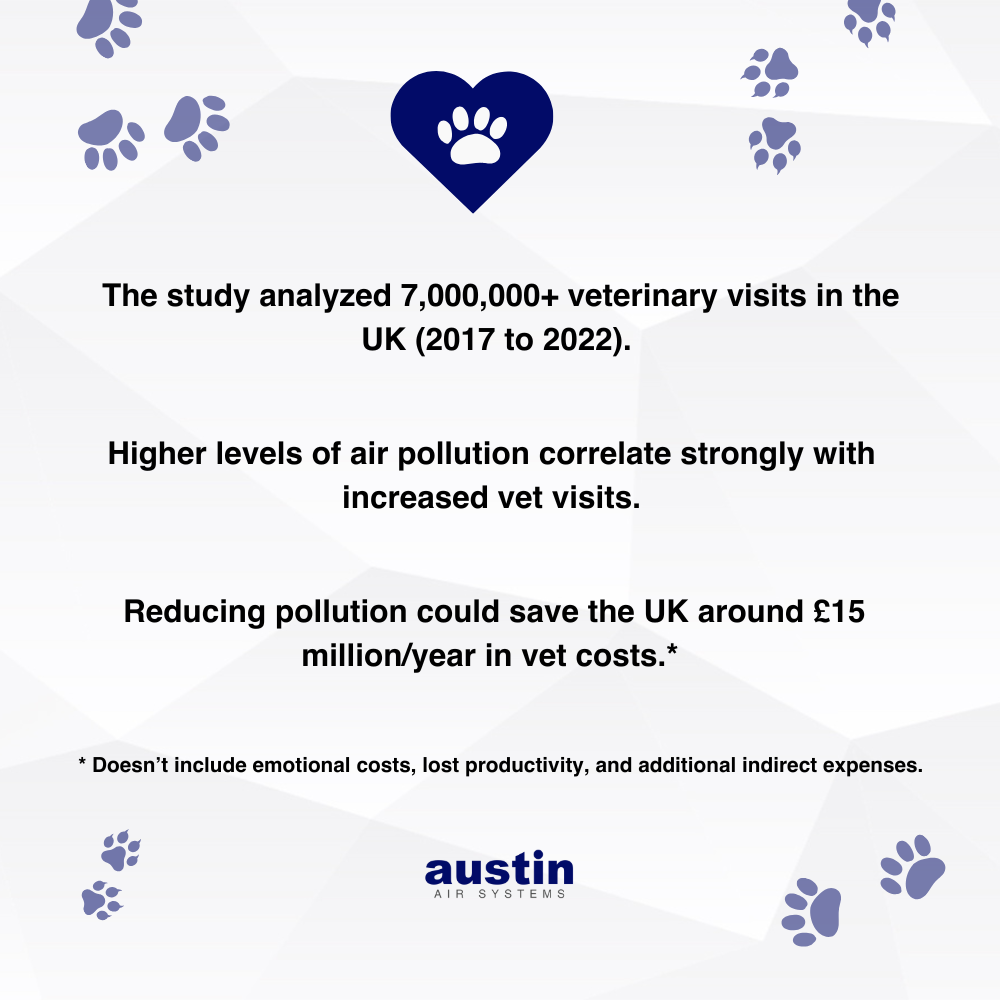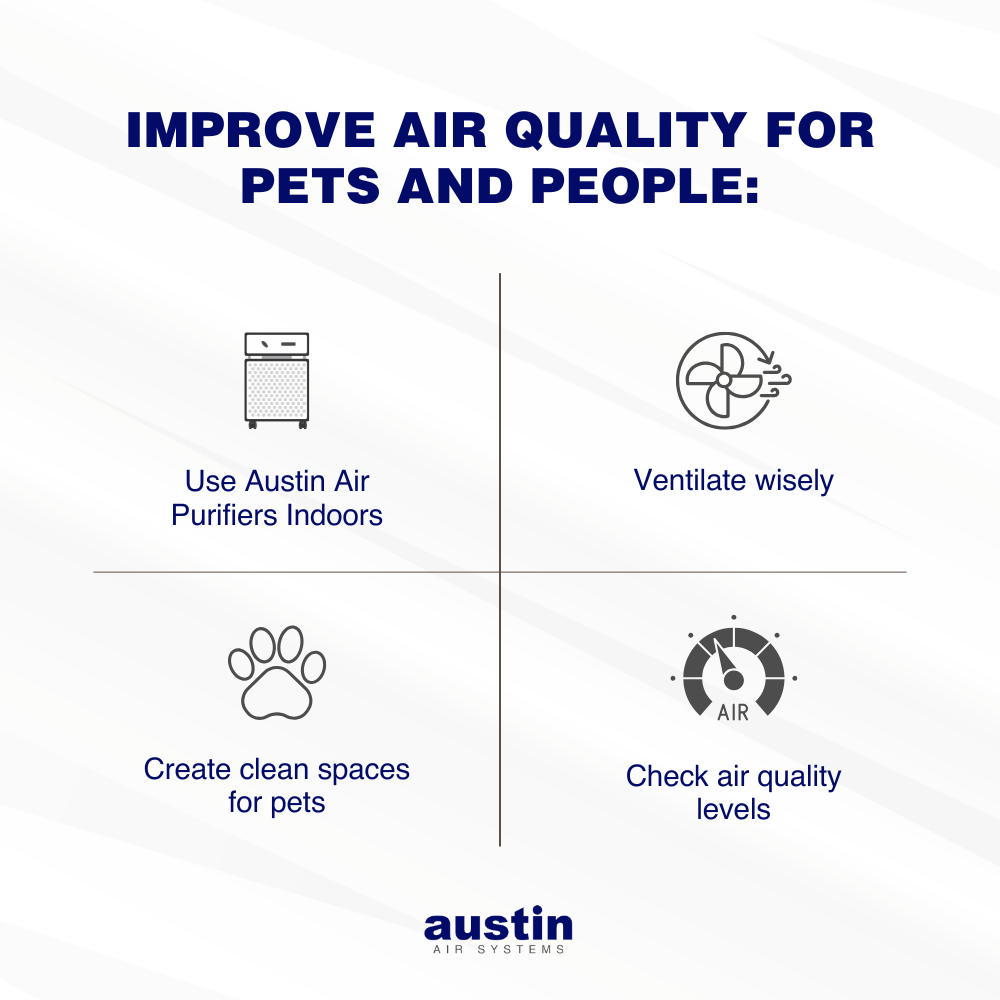Air quality has long been associated with health risks for humans, with fine particulate matter (PM2.5) linked to respiratory, cardiovascular, and even cognitive issues. However, there has been less attention to the effects of air pollution on our pets—until now.
A groundbreaking study by the Grantham Research Institute on Climate Change and the Environment has brought much-needed focus to this issue, revealing the significant health impacts air pollution has on cats and dogs.1 The study estimates that reducing pollution could prevent over 80,000 vet visits annually in the United Kingdom alone. This could potentially save pet owners millions in medical costs.
Let’s explore the findings of this research and what they mean for pet owners, pets, and policy makers worldwide.
Key Findings: How Pollution Affects Pets
The study analyzed over seven million veterinary visits in the UK from 2017 to 2022. Researchers found that higher levels of air pollution correlate strongly with increased vet visits for common pet ailments. In fact, a 1 microgram per cubic meter increase in PM2.5 exposure over the course of a week was associated with a 0.7% increase in admissions for both cats and dogs.
This statistic may seem small, but with millions of pets exposed across the country, the overall effect is substantial.
Much like humans, pets can experience respiratory issues and other health complications from air pollution. The study identified an increase in certain categories of veterinary visits that could plausibly be driven by poor air quality. This includes visits related to breathing difficulties, coughing, and other respiratory symptoms.
However, it didn’t find the same trend in visits unrelated to air quality, such as routine vaccinations or post-operative care, reinforcing the link between pollution and respiratory health.
The Costs of Pollution-Related Pet Healthcare
The economic toll of pollution-related pet healthcare is equally significant. The study estimates that reducing pollution to levels recommended by the World Health Organization could save the UK around £15 million annually in pet healthcare costs. This calculation covers only the direct costs of veterinary care, meaning the true economic impact is likely much higher when considering emotional costs, lost productivity, and additional indirect expenses.
Shared Environments, Shared Health Risks
Pets live in the same environments as their human companions, meaning they’re exposed to the same levels of ambient pollution indoors and outdoors. This co-exposure makes pets susceptible to similar health issues as humans, even though research has primarily focused on human health impacts. Pets’ respiratory systems and other biological pathways share many traits with ours, which can make them equally vulnerable to pollution, particularly for animals with pre-existing health issues like asthma.
What This Means for Pet Owners
The findings are a call to action for pet owners who may not have considered air quality’s role in their pets’ well-being. By improving indoor and outdoor air quality, pet owners can help protect their pets’ health and avoid potentially costly and stressful vet visits. Here are some ways to start:
Use Air Purifiers Indoors: High-quality, medical-grade Austin Air Purifiers that target PM2.5 particles can reduce indoor exposure, which is particularly important in urban areas or during pollution events like wildfire season.
Ventilate Wisely: Avoid high-traffic times when opening windows or taking pets outside, as pollution levels can be significantly higher during rush hours.
Create Clean Spaces for Pets: Keeping your pet’s bedding and play areas dust-free and vacuumed can help mitigate indoor pollution from trapped allergens and particles.
Check Air Quality Levels: Monitoring air quality websites, especially before outdoor activities, can help you plan walks and playtime for the healthiest times of day.
The Bigger Picture: Policy Implications and Future Research
This study adds to a growing body of evidence showing the widespread health impact of air pollution across species. Beyond human health, reducing pollution could lead to a better quality of life for pets, providing an additional incentive for policymakers to prioritize air quality improvements. Dr. Stephen Jarvis, Assistant Professor in Environmental Economics at the London School of Economics and co-author of the study, emphasized that improving air quality isn’t just beneficial for people; it’s good for pets, too.
As our understanding of air pollution’s impact on pets expands, the hope is that future research and policies will continue to take these findings into account. As pet care spending continues to grow globally, with Americans spending $120 billion and UK residents £10 billion on pets in 2022 alone, the importance of protecting pets from air pollution becomes even clearer. Improving air quality could bring both economic and emotional benefits to pet owners, reducing vet bills and enhancing pets’ overall health and well-being.
For pet owners, improving air quality could mean fewer trips to the vet, lower healthcare costs, and a longer, healthier life for their beloved furry friends. With such a compelling case for clean air, the message is clear: tackling pollution benefits everyone—humans and pets alike.
REFERENCE
1 Deschenes O, Jarvis S, Jha A and Radford AD. (October 2024) The impact of air pollution on petcare utilization. Grantham Research Institute on Climate Change and the Environment Working Paper 412. London: London School of Economics and Political Science.



